Page 1 of 2


Review: OCZ brewed a good one
We had a chance to play around with OCZ's latest venture in its peripheral product lineup, a new keyboard called Elixir. The Elixir is a part of OCZ's Alchemy series, which is going to be a budget-oriented product series, and the Elixir keyboard is no exception, as it sells at just over €20 in Europe, or $30-40 in the States.
OCZ, on the other hand, isn't new in the peripheral business, as they've already launched quite a few products in the Rodentia order, which are mostly called rodents, and some called them mice. (So, we're a zoology site, now? sub.ed.) We had a chance to test their latest OCZ Dominatrix mouse, which turned out to be quite a performer in its price class.
Due to the fact that we are talking about a budget keyboard, OCZ had to cut some corners to keep the price at a budget level, so the lack of additional USB ports is understandable, but we will get to those shortcomings a bit later. On the other hand, in contrary to the low price, OCZ has included some nice features which can only be found on far more expensive keyboards that usually end up priced in the €60-80 region.
The keyboard comes packed in a standard cardboard box, which shows the keyboard and all its features. The package includes the keyboard, a quick guide, a driver CD and a pack of replacement keys. We must compliment OCZ on the replacement keys, as this is not something you see every day, especially not in the budget market segment.
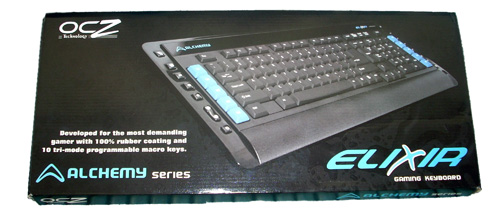
As this is a gaming keyboard, OCZ has decided to include replacements for the WASD cluster, arrow keys, left shift and the space bar, basically all keys that a gamer can't live without. It's a small gesture and something that you would expect to get when you pay €60-80 for a keyboard.
The keyboard looks solid and well built. We aren't a great admirers of glossy surfaces, as those tend to be a magnet for fingerprints and a keyboard certainly gets a lot of them. OCZ apparently shares our way of thinking and they only used the glossy surface on the part of the edge of the keyboard, where extra/media keys are located. The plastic leather textured wrist rest is a bit narrow and fixed to the keyboard so it can't be removed.
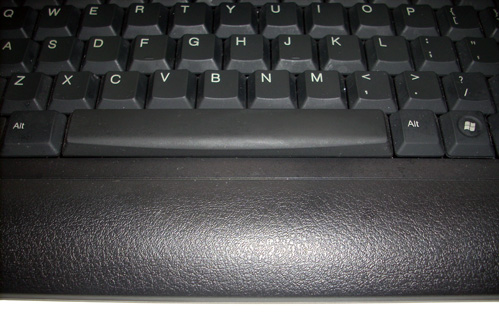
As we mentioned, all of the keys are rubber coated. except for those 16 extra/media keys. It's not that we hear a lot of people complaining about slippery, glossy keys, but they do feel nice when they are rubber coated.
As far as the layout goes, as you can see from the picture below, the keyboard uses a rather weird setup. The double sized Delete key is the first one caught our eye. This makes the Insert key rather inaccessible due to its position by the "Print Screen/Scroll Lock/Pause Break cluster. The double-sized Delete key also changes the traditional Home/End/Page Up/Page Down layout. Call us old-fashioned, but the old layout worked flawlessly for us.

The OCZ Elixir is a gaming keyboard, and as such, it must have macro keys. OCZ has placed ten of these and changed their color to blue. You can find five of these keys on each side of the keyboard, marked as L1-L5 and R1-R5, depending on which side are you're looking at. The Elixir also features 16 extra and media keys, eight on each side. These extra/media keys are also the only ones that didn't get the rubberized treatment on this keyboard.
OCZ also decided to ditch the left Windows key, probably due to the fact that this is a gaming keyboard and OCZ wanted to eliminate the chance of accidentally hitting the Windows key during a gaming match. From our perspective, this is a bad thing, as it adversely influences normal, everyday use of this keyboard. If you are used to Windows shortcuts like "win+e" for the Explorer, "win+d" or "win+r" for the "show desktop" and "run" commands, you will find this keyboard to be a bit annoying; as we caught ourselves hitting the blank space between the left CTRL and ALT keys more than once. This is purely subjective and not a big deal once you get used to it. Gamers might consider this a useful feature, but we would rather like to have it there and to be able to deactivate it via another key or the included software.
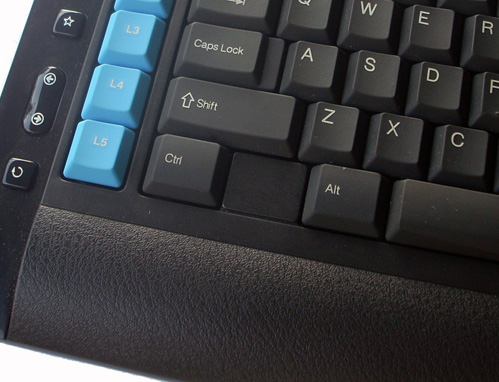
Before we get to those neat blue colored macro keys, let's talk about those extra/media keys. As we said before, OCZ has placed 16 of these, eight on each side of the keyboard. The left side carries (top to bottom) normal/gaming mode switch button, explore, mail, home/launch browser and favorites keys, double key for back and forward in your favorite browser and the refresh key.
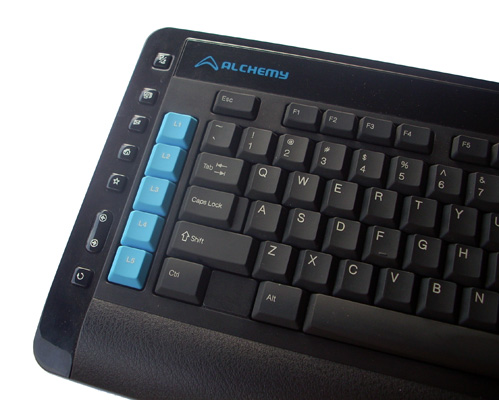
The right side is reserved for media, and it has launch player button on the top followed by the play/pause, stop, next and previous keys, double key for volume up and down and the mute key. The only bug that we could find is that these buttons didn't work with our Winamp player which isn't included in the list of programs. It can launch it, but the play, stop, next and previous buttons are useless. On the other hand, it work flawlessly with Windows Media Player.
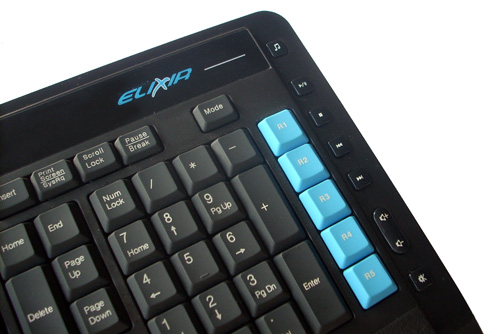
As we mentioned earlier in the review, OCZ has also placed ten extra macro keys which are colored in a light blue color. These are placed very close to the rest of the keys, so occasionally, at least until you get used to the keyboard, you might hit them instead of the left ctrl, shift or the num-pad enter on the left side. These keys are labeled as the L1-L5 and R1-R5 and are completely customizable via the included Alchemy Elixir software.
The last key that we have to mention is the "Mode" key placed above the num-pad close to the status LEDs. This one shifts between three different profiles that you can save in Alchemy Elixir.
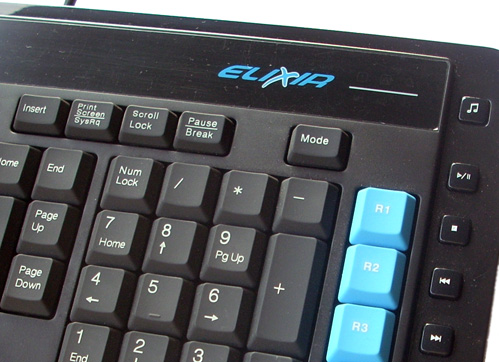
Prev Next »
